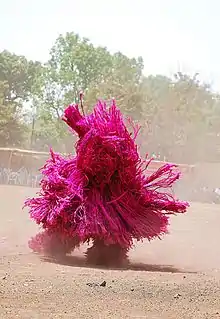FESTIMA
The Festival International des Masques et des Arts (International Festival of Masks and the Arts), or FESTIMA, is a cultural festival celebrating traditional African masks held in Dédougou, Burkina Faso.[1] Founded to help preserve traditional cultural practices in the modern age, FESTIMA features masks and traditions from several West African countries.[2] It is currently held biennially in even-numbered years.[3] The most recent edition, the fourteenth, was held from February 24 to March 3, 2018.[1][4]
| International Festival of Masks and the Arts Festival International des Masques et des Arts | |
|---|---|
 A masked dancer performing at the 2014 festival | |
| Status | Active |
| Genre | Cultural festival |
| Frequency | Biennial |
| Location(s) | Dédougou |
| Country | Burkina Faso |
| Inaugurated | 1996 |
| Founder | Association for the Protection of Masks (ASAMA) |
| Previous event | 2018 |
| Next event | 2020 |
History
In 1996, a group of Burkinabé students founded ASAMA, the Association for the Protection of Masks, in order to promote and preserve traditional mask practices.[3][5] One of the concerns is that traditional masks are no longer a regular part of life for many. The masks' origins are religious in nature, historically being associated with animism.[6] Animism and other traditional beliefs are minority religions in modern Burkina Faso, with estimates indicating they are practiced by between 7.8[7] and 15 percent[8] of the population. The majority religion in the country is Islam, which does not use the masks in their ceremonies.[2] However, members of ASAMA believe that traditional masks can still be important culturally even to those for whom they are not important religiously. According to Ki Leonce, executive director of ASAMA, "There are two aspects about masks. One is cult and the other is culture; there might be a religious conflict for people who venerate masks, but there is no conflict from the cultural point."[6]
The original FESTIMA, held in 1996, was four days long, and the event has since expanded to seven days.[3][9] The thirteenth edition of the festival was held from February 27 to March 5, 2016, and featured masks from over 50 communities from six West African countries: Burkina Faso, Benin, Ivory Coast, Mali, Senegal, and Togo.[2][10] ASAMA estimated 100,000 people attended the event,[2] including more than 2,000 international tourists.[10]
Events
The primary events of FESTIMA are the performances, where mask wearers dance, accompanied by musicians playing hand drums, whistles, and balafons.[3][5] Sometimes, a translator is present to interpret the meaning of the dance.[6] Some of the ethnic groups whose traditions are represented are the Bwaba, Marka, and Yoruba.[2]
FESTIMA also includes seminars on historical and cultural topics, storytelling competitions, educational events for children, and a marketplace.[2][3][5]
References
- "FESTIMA". Official FESTIMA Website. Retrieved January 11, 2018. (in French)
- Page, Thomas (May 13, 2016). "The masked men of Burkina Faso". CNN. Retrieved January 11, 2018.
- "FESTIMA 2018 in Dédougou, Burkina Faso". Everfest. Retrieved January 11, 2018.
- Kapigdou, Merveille (February 25, 2018). "FESTIMA 2018 : C'est parti à Dédougou !". Burkina 24. Retrieved August 28, 2019. (in French)
- Harris, Rachel Lee (January 8, 2016). "Where Music Lovers Should Go in 2016". New York Times. Retrieved January 11, 2018.
- Loov, Jacob Balzani (March 13, 2016). "In Burkina Faso: FESTIMA, a festival of African masks". Al Jazeera. Retrieved January 11, 2018.
- "The World Factbook". CIA. January 9, 2018. Retrieved January 16, 2018. Estimate is from 2010.
- "Enquête Démographique et de Santé et à Indicateurs Multiples" (PDF). Demographic and Health Surveys. April 2012. p. 3. Retrieved January 16, 2018. Estimate is from 2006. (in French)
- Sweet, Jonathan (February 17, 2016). "FESTIMA – Burkina Faso's festival of masks". Yettio. Retrieved January 11, 2018.
- Sawadogo, Tiga Cheick (March 1, 2016). "FESTIMA 2016 : Des infrastructures pour sauvegarder les masques". LeFaso.net. Retrieved January 11, 2018. (in French)
External links
- Official site (in French)